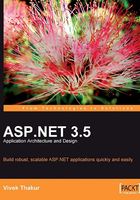
What This Book Covers
Chapter 1 will introduce you to architecture and design in ASP.NET, including tiers, layers, and logical structuring.
Chapter 2 discusses the advantages and disadvantages of using the simplest and easiest 1-tier, 1-layer default architecture in ASP.NET. You will also understand when and why we should use out-of-the-box data source controls, and how the 1-tier, 1-layer style is tightly-coupled and is not flexible or scalable.
Chapter 3 discusses what an ER diagram is, the domain model, the basics of UML, and what an n-layer design is, and how it increases the flexibility and maintainability of the code when compared to a 1-layer architecture. A sample project is explained with code in a 3-layer model. The drawbacks or limitations of this model are also discussed.
Chapter 4 talks about n-tier architecture in ASP.NET and how to implement it. It also explains Data Transfer Objects and how to use them with 4-tier and 5-tier web solutions.
In Chapter 5, you will learn and understand what MVC design is, and how the ASP.NET MVC framework helps us quickly implement MVC design in our web applications.
In Chapter 6, you will learn how and when to use the most common design patterns in ASP.NET: Factory, Dependency Injection, Singleton, and others.
Chapter 7 explains why we need SOA, explaining the advantages of SOA for a beginner. A sample project using SOA architecture is discussed. The chapter also explains how the Windows Communication Framework (WCF) compliments SOA.
Chapter 8 deals with the importance of a well-designed database, balanced normalization, logical and physical models, and tips and tricks for better database models.
Chapter 9 covers localization for ASP.NET applications, the deployment of localized applications, the localization framework, and best practices.